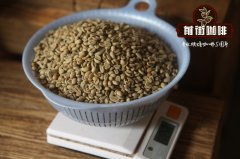Honduran coffee beans what are the flavor and taste characteristics of washed Kaduai coffee beans in Santa Tamata Manor?

Professional coffee knowledge exchange more coffee bean information please follow the coffee workshop (Wechat official account cafe_style)
Honduran coffee beans what are the flavor and taste characteristics of washed Kaduai coffee beans in Santa Tamata Manor? The variety advantage of Honduran coffee beans?
Honduras has always been among the top few in the boutique coffee market, but Honduras has the advantages of natural environment, such as excellent soil quality, altitude and climatic conditions. Nearby Guatemala, El Salvador and Nicaragua also have advanced coffee production. What Honduras lacks is infrastructure and its reputation in the consumer market is not good enough. Hongguo is better known for commercial beans than boutique beans. No matter how good the quality is, there is no way to sell them at a good price. Many beans from Koban and Santa Barbara are mixed with fish eyes as Guatemala beans, and they are sold at the price of Guatemalan beans, and for a long time they are not aware of their own potential for the cultivation of high-quality coffee beans. The main problem is that coffee cherries are only slightly processed. It is sold to the processing plant when it is still wet, which often causes coffee cherries to become moldy and damaged before they are officially dried until the moisture content is only 12%. Such cherries become defective beans after drying. Since there is no relative price return for good quality, coffee farmers, processors and exporters have no incentive or incentive to increase costs to develop the potential for coffee cultivation, so that the end of Honduran coffee beans has become recognized as a mild mixed bean. rather than beans from a single origin or unique farm, this is a vicious circle.
But now it's different, with the help of USAID and Fintrac and several cooperatives like La Central, they try their best to promote and educate Macro bean farmers to produce good coffee, and then properly handle it to maximize the flavor of the final coffee. In addition, the Fair Trade Association (Fair Trade) funded the construction of processing equipment and increased the expertise of coffee farmers to gradually bring Honduran coffee out of the trough. It has become a burgeoning Central American coffee in the past year or two.
Honduras is as diverse as other producing countries, and I can't cover them all in one way. The largest producing area is Santa Barbara Santa Barbara, and there are other producing areas such as Copan Koban, Ocotepeque Ocotepec, Lempira Lompilla, La Paz Baz, and El Paraiso Periso in the south, which are planted at an altitude of 1500 meters to 2000 meters above sea level. Mainly grow extremely high sea beans (SHG) generally speaking, the Honduran coffee we have recently tested has low acidity, high sweetness and obvious caramel flavor, which is an excellent choice for espresso beans.
Farm name: Finca Santa Marta Santa Mata
City City: Tegucigalpita, Yoro
Region producing area: Ocotepeque Ocotepec
Country countries: Honduras Honduras
Altitude altitude: 1250-1480 m
Farm Size farm size: 59 Hectares 59 ha
Coffee growing area Coffee planting area: 3 Murray 5 Hectares ha
Annual Precipitation annual rainfall: 1300 haomi mm
Soil soil: Clay loam, sandy loam clay, sandy soil
Annual Production annual output: 400 bags of green coffee beans 400 bags of raw beans
Certification Certification: organic Organic
Shade Trees shade tree species: Guama, Liquidambar, Oak, Cedar, Guajiniquel and Musaceas melon horse, maple tree, oak, cedar, plantain
Water Source Water Source: natural Water Source of Natural Water Sources from the Santa Marta Farm Farm
Coffee Characteristics: coffee characteristics
Variety varieties: Kaddura, Kaduai
Processing System treatment: Washed washing drying on the sun table
Kaddura, a single gene variant of Bourbon bourbon, was found in Brazil in 1937. It has better production capacity and disease resistance than bourbon, and the tree is shorter and easy to harvest. Unfortunately, like bourbon, it has the periodic problem of production capacity fluctuation every two years. But its flavor is comparable to or slightly worse than bourbon beans, more importantly, super adaptability, no shade trees, direct exposure to the sun can also be full of vitality, commonly known as exposed coffee (Sun Coffee), can adapt to high-density planting, but must apply more fertilizer to increase costs, so the acceptance of coffee farmers is not high in the initial stage.
But soybean prices soared in the 1970s, and farmers switched to Kaddura to increase production, which was vigorously promoted by the Brazilian and Colombian authorities and yielded fruitful results. The acceptance of Kaddura by farmers means a great change in planting technology. Brazil and Colombia switched to high-yield, high-density sun-exposed planting. by 1999 ○, 14 million bags of coffee beans could be harvested on 1 million hectares, increasing production capacity by 60%. No wonder Kaddura, with high production capacity and high quality, has become a variety relied on by various producing countries.
Kaddura is suitable for planting in the high altitude area from 700m to 1700 m, with strong adaptability to altitude, but the higher the altitude, the better the flavor, and the production capacity is relatively reduced, which is the fate of fine beans. In academic circles, some people call Kaddura the bourbon of dense and exposed version, which can be said to hit the nail on the head. There is also a variety of yellow Kaddura (Caturra Amarello) in Central and South America, but the wind rating is not as good as Huang bourbon.
When Kaddura is slightly roasted, the sour aroma is obvious and the whole is bright. If handled properly, the sweetness can be very good, but the mellowness of coffee is relatively low compared with bourbon, and the cleanliness of the taste is a little less.
Kaddura usually has red berries, but there are very few areas with yellow Kaddura, such as Hawaii, where there are very few yellow Kaddura.
Important Notice :
前街咖啡 FrontStreet Coffee has moved to new addredd:
FrontStreet Coffee Address: 315,Donghua East Road,GuangZhou
Tel:020 38364473
- Prev

Honduras Manor Coffee beans Tropical Rain Forest certified flavor of washed beans from SHG St. Vincent treatment Plant
Professional coffee knowledge exchange more coffee bean information please follow the coffee workshop (Wechat official account cafe_style) Honduran manor coffee beans tropical rain forest certified SHG St. Vincent processing plant Honduran water washed beans flavor and taste characteristics? Production area: Santa Barbara province (Santa Barbara) Pena Blanca town processing plant: St. Vincent processing plant (Beneficio)
- Next

What are the flavor and taste characteristics of washed coffee beans in Huayang Mello Manor, St. Vincent, Honduras?
Professional coffee knowledge exchange more coffee bean information please follow the coffee workshop (Wechat official account cafe_style) Honduras St. Vincent processing plant Huayang Merlot washed coffee beans flavor and taste characteristics? What are the characteristics of the variety of Pacas in Honduras? Treatment: washed bean seed: 100% Arabikapakas flavor: red grape blackcurrant cashew fresh cedar coke
Related
- Detailed explanation of Jadeite planting Land in Panamanian Jadeite Manor introduction to the grading system of Jadeite competitive bidding, Red bid, Green bid and Rose Summer
- Story of Coffee planting in Brenka region of Costa Rica Stonehenge Manor anaerobic heavy honey treatment of flavor mouth
- What's on the barrel of Blue Mountain Coffee beans?
- Can American coffee also pull flowers? How to use hot American style to pull out a good-looking pattern?
- Can you make a cold extract with coffee beans? What is the right proportion for cold-extracted coffee formula?
- Indonesian PWN Gold Mandrine Coffee Origin Features Flavor How to Chong? Mandolin coffee is American.
- A brief introduction to the flavor characteristics of Brazilian yellow bourbon coffee beans
- What is the effect of different water quality on the flavor of cold-extracted coffee? What kind of water is best for brewing coffee?
- Why do you think of Rose Summer whenever you mention Panamanian coffee?
- Introduction to the characteristics of authentic blue mountain coffee bean producing areas? What is the CIB Coffee Authority in Jamaica?

